Students can access the CBSE Sample Papers for Class 10 Science with Solutions and marking scheme Term 2 Set 3 will help students in understanding the difficulty level of the exam.
CBSE Sample Papers for Class 10 Science Term 2 Set 3 with Solutions
Time allowed: 2 Hours
Maximum Marks: 40
General Instructions:
- All questions are compulsory.
- The question paper has three sections and 15 questions. ALL questions are compulsory.
- Section-A has 7 questions of 2 marks each; Section-B has 6 questions of 3 marks each, and Section-C has 2 case based questions of 4 marks each.
- Internal choices have been provided in some questions. A student has to attempt only one of the alternatives in such questions.
SECTION – A
Question 1.
A current flows in a wire running between the S and N poles of a magnet lying horizontally as shown in the figure below.
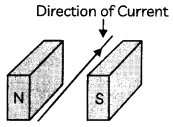
What will be the direction of force on the wire due to the magnet?
OR
A constant current flows in a horizontal wire in. the plane of the paper from east to west as shown in the figure.
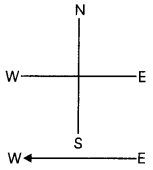
What will be the direction of magnet field at a point directly below the wire? (2)
Answer:
The direction of force on the wire due to the magnet will be vertically downwards.
Explanation:
The direction of force experienced by a current carrying conductor placed in a magnetic field is given by Fleming’s left hand ruLe. Applying this rule, we find that force will act vertically downwards.
OR
The direction of magnetic field at a point directly below the wire will be from North to South.
Explanation:
If we observe the direction of the magnetic field by applying the right hand thumb rule, then we will find that the direction of the magnetic field is from north to south below the wire.
Question 2.
Three elements X, Y, and Z with their atomic numbers are given below:

Examine the given data and answer the following questions:
(A) How many valence electrons are present in Y? What is its valency? (1)
Answer:
Valence electrons present in Y are 8. Its valency is zero.
Explanation: The number of electrons present in the outermost orbit are called valence electrons. The electronic configuration is 2, 8, 8. Here the outermost shell has 8 electrons so valence electrons are 8. Outermost orbit of Y element has 8 electrons. Its outermost orbit has complete octet (fully filled orbit) so it cannot accommodate any other electron, therefore its valency is zero.
(B) Write the position of X and Z in the Modern Periodic Table. (1)
Answer:
X element will be present towards the right of the table as it is a non-metal.

Z element will be present towards the left of the periodic table.

Explanation: The number of valence electrons determine the group number. The number of shells determine the number of periods. In X the number of shells are 3, so it belongs to 3rd period and Z has four shells so it belongs of 4th period.
Question 3.
In the given figure, the various trophic levels are shown in a pyramid. At which trophic level is maximum energy available and why?
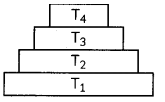
OR
Look at the given figure and find out which trophic level would have the maximum concentration of pesticides in their bodies and why? (2)
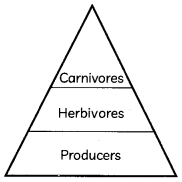
The maximum energy is available at T
1
. At each trophic level, most of the energy available is utilised for respiration and excretion and other life processes and only ten percent of the available energy is passed on to the next level Because only 10% of the available energy can be passed on to the next trophic level, higher trophic levels have substantially less energy content and the number of trophic levels in a food chain is limited. The lower the trophic level higher will be energy content.
Hence, the greatest amount of energy is expected in trophic level T
1
.
Hence, T
1
> T
2
> T
3
> T
3
.
OR
The carnivores would have the highest concentration of chemicals in their bodies due to biological magnification. The successive increase in the concentration of some chemicals through different trophic levels of a food chain in an ecosystem is biological magnification. The pesticides are used to protect crops. Being non-biodegradable, these pesticides are not destroyed and they enter the food chain at the level of producer by absorption along with water and minerals. From producers they enter herbivores and from herbivores to cornivores. As they move up in the food chain, they become more and more concentrated at each level.
Question 4.
Trace and note the sequential series of events, that occurs in the female reproductive system post intercourse. How does these events lead to pregnancy? (2 )
Answer:
The sperms enter through the vaginal passage during sexual intercourse. They travel upwards and reach the oviduct where they may encounter the egg. The fertilised egg (zygote) starts dividing and forms a ball of cells or embryo. The embryo is implanted in the lining of the uterus where they continue to grow and develop organs to become foetus. The uterus prepares itself every month to receive and nurture the growing embryo. The lining thickens and is richly supplied with blood to nourish the growing embryo.
Question 5.
Identify and name the functional groups present in the following compounds:
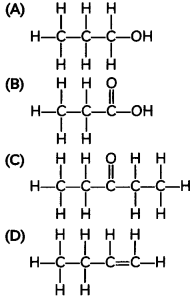
Answer:
(A) Functional group: —OH
Name of the functional group: Alcohol
(B) Functional group:
![]()
Name of the functional group: Carboxylic acid
(C) Functional group:
![]()
Name of the functional group: Ketone
(D) Functional group:
![]()
Name of the functional group: Alkene
Question 6.
In human beings, the statistical probability of getting either a male or female child is 50:50. Give a suitable explanation. (2)
Answer:
During spermatogenesis in males, two types of gametes are produced. 50% of the gametes produced carry X chromosomes, whereas 50% of the gametes carry Y chromosome. On the other hand, females produce only one type of ovum containing X-chromosomes. There is an equal probability of fertilization of the ovum with the sperm carrying either X or Y chromosomes. The sex of the children will be determined by what they inherit from their father.
A child who inherits an X chromosome from her father will be a girl, and one who inherits a Y chromosome from him will be a boy.
Since the ratio of male gametes containing X chromosome and those containing Y chromosome is 50:50, the statistical probability of a male or a female infant is also 50:50.
Question 7.
What would be the ratio of chromosome numbers between an egg and a zygote? How is the sperm genetically different from the egg?
OR
(A) Pollination may occur without fertilization but fertilization will not take place without pollination. Give reasons
(B) Give an example of bisexual flower. What is its female reproductive part known as? (2)
Answer:
The ratio of chromosome numbers between egg and its zygote is 1:2.
Both sperm and egg contain half number of chromosomes, i.e., 23 chromosomes. Sperm is genetically different from the egg in the way that it contains either X or Y chromosome, whereas an egg always contains an X chromosome.
OR
(A) Pollination is just the transfer of pollen grains from the anther of stamen to the stigma of pistil. It is carried out by agents like wind, insect etc. For pollination to happen there is no need of fertilization of gametes i.e. their union. Fertilization is fusion of male and female gamete and this process is facilitated by pollination. By pollination, pollens are brought to eggs so that they can fuse and fertilisation can take place. Therefore, pollination may occur without fertilisation but fertilisation will not take place without pollination.
(B) A flower that contains both the male and female reproductive structures (stamen and pistil) is called a bisexual flower. Example: rose, hibiscus. Its female reproductive part is known as the carpel or pistil
SECTION – B
Question 8.
(A) Nichrome is used to make the element of electric heater. Why? (1)
Answer:
Nichrome is used to make the element of an electric heater because nichrome is an alloy which has high resistivity and high melting point.
(B) You have two metallic wires of resistances 60 and 30. How will you connect these wires to get an effective resistance of 20? (1)
Answer:
If the two wires are connected in parallel then the combination will give 2 ohms.
R
1
= 6Ω, R
2
= 3Ω
Effective resistanes = 2Ω
\(\frac{1}{R_{p}}=\frac{1}{R_{1}}+\frac{1}{R_{2}}\)
= \(\frac{1}{6}+\frac{1}{3}=\frac{1+2}{6}=\frac{3}{6}\)
R
p
= 2 – Ω
(C) Calculate the number of electrons constituting one coulomb of charge. (1)
Answer:
I = q/t = ne/t where n = no of electrons,
e = electronic charge, t = time.
Hence, n = It/e = q/e
= 1 C/1.6 × 10
-19
= 6.25 × 10
18
electrons
Question 9.
Carbon belongs to group 14 of the periodic table. It has four valence electrons. Suggest a method by which it forms stable compounds. Also provide reasons why compounds formed by carbon have low melting and boiling points. (3)
OR
(A) Determine the number of electrons . involved in bonding of isobutane. Also draw its structure. (2)
(B) In organic compounds, certain groups orient the physical and chemical properties of the compounds. Identify these parts and assign their rotes.
Answer:
As carbon belongs to group 14 of the Modern periodic table. It has 4 valence electrons and thus, carbon cannot lose 4 valence electrons or gain the same. Thus, it shares the 4 valence electrons with other atoms. Thus, its forms stable bonds called as covalent bonds. The compounds formed by this type of interaction are called as covalent compounds.
Covalent compounds generally have low melting and boiling points due to the presence of weak interactive forces present in such compounds. These forces can be easily broken and thus such compounds have low melting and boiling points.
OR
(A)
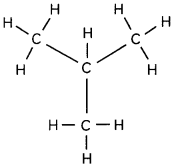
The total number of covalent bonds present in the above compound is 13. A single bond is formed by the sharing of two electrons. The above compound involves 13 single bonds, thus, 26 electrons are involved in the formation of iso butane.
Related Theory
Isobutane, also known as i-butane, 2-methylpropane or methylpropane, is a chemical compound with molecular formula HC(CH$3. It is an isomer of butane. Isobutane is a colourless, odourless gas. It is the simplest alkane with a tertiary carbon atom.
Caution
Students need to draw the structure of isobutane and then count the total number of bonds involved in formation of isobutane. Students need to convert the number of bonds into electrons before quoting down the answer.
(B) An organic compound consists of an alkyl group and functional group. The functional group largely determines physical and chemical properties of the compound. The alkyl group also helps in determining the physical properties of the compound to an extent.
Related Theory
Organic chemistry is dominated by the ’functional . group approach”, where organic molecules are deemed to be constructed from:
An inert hydrocarbon skeleton onto which functional groups (FGs) are attached or superimposed.
The functional group approach “works’ because the properties and reaction chemistry of a particular functional group (FG) can be remarkably independent of environment Therefore, it is only necessary to know about the chemistry of a few generic functions in order to predict the chemical behaviour of thousands of real organic chemicals.
An alkyl is a functional group of an organic chemical that contains only carbon and hydrogen atoms, which are arranged in a chain. They have general formula C n H 2n+1 .
Question 10.
(A) Is it possible that the food chain has more than six steps? Support your answer with reasons. (1½)
Answer:
It is not possible that the food chain has more than six trophic levels. This is because of loss of 90% energy at each trophic level and only 10% of energy is available at each successive level. In a food chain having more than six steps, energy available to the top carnivore will not be sufficient for his survival.
(B) Give three characteristics of the food chain. (1½)
Answer:
(i) A food chain is always straight and proceeds in a progressive straight line.
(ii) A food chain helps in understanding the food relationship and interaction among various organisms in an ecosystem
(iii) It also helps to understand the movement of toxic substances in an ecosystem and the problem of their biological magnification.
Question 11.
(A) Identify a, b, c and d In the given diagram and write their names. (2)
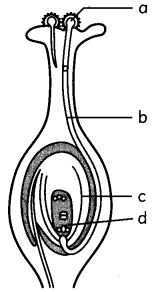
(B) Explain the process of fertilization in flowers. (1)
OR
(A) “The reduction in the weight of an organism due to starvation is not genetically controlled.” Comment on this statement. (1)
(B) When does the formation of new species occur? (1)
Answer:
(A) ‘a’ represents the pollen grain
‘b’ represents the pollen tube
‘c’ represents the ovary
‘d’ represents the female germ cell
(B) Fertilisation occurs when the male gamete present in a pollen grain joins with the female gamete or egg present in ovule. When the pollen grain falls on the stigma of the carpel, it bursts open and grows a pollen tube downward through the style towards the female gamete in the ovary. Here, zygote is formed which later grows into embryo. Zygote divides repeatedly to form an embryo within the ovule. Ovule develops a thick coat and gradually forms seed. Ovary of flowers develops and becomes a fruit
OR
(A) The reduction in the weight of an organism due to starvation is not genetically controlled as it will not change the DNA of the germ cell. It is an environmentally determined factor. Weight loss or gain occurs due to external factors such as food and is not genetically controlled. Hence, low weight parents can have heavy weight progeny due to difference in food habit.
(B) New species may be formed if DNA undergoes significant changes in germ cells and the chromosome number changes in the gamete. Changes in DNA will be inherited by the germ cells. Germ cells which when passes to the next generation will be inherited in the subsequent generation. Change in the chromosome number makes a change in the gametes which leads to change in the gene pool. This leads to new variations.
Question 12.
(A) An electric heater is rated at 2 KW electrical energy cost 4 per kWh. What is the cost of using the heater for 3 hours? (1)
Answer:
₹ 24
Given P = 2 kW, t= 3 hours, Rate( R) = ₹ 4 per kWh
Hence, Cost = PtR = 2 × 3 × 4 = ₹ 24
(B) Derive the equation P = VI from Joule’s law of heating equation. (2)
Answer:
The Joule’s law of heating equation states that W = l
2
Rt. Power is defined as P = W/t which gives P = l
2
R. Since V = IR from Ohm’s law hence we can replace R = V/l. We get P=VI.
Question 13.
(A) X, Y and Z are the elements of Dobereiner’s triad. If the atomic mass of X is 7 and that of Z is 39, what should be the atomic mass of Y? (1)
Answer:
As the elements X, Y and Z are the elements of Dobereiner’s triad, they will follow its principle. According to Dobereiner, when elements are arranged in increasing order of their atomic masses, the arithmetic mean of the atomic masses of the first and third element in a triad is approximately equal to the atomic mass of the second element in that triad.
Therefore, (Atomic mass of x + Atomic mass of z)/2 = Atomic mass of y
= (7+39)/2
= 46/2
= 23
Atomic mass of Y = 23
(B) Element ‘X’ forms a chloride with the formula XCl
2
, which is a solid with high melting point. X would most likely be in the same group of the periodic table as which of the following elements: Si, Mg, Al, Na. Explain with suitable reasoning. (2)
Answer:
The element X has a valency of 2 which is evident from the formula XCl2. As the melting point is high, then it must be an ionic compound. From the following elements, Na, Mg and Al are metals that can form ionic compounds. Now, the element needs to have the valency of 2. From amongst these elements, only Mg has valency of 2. Thus, the element is Magnesium, Mg.
An ionic compound is a chemical compound composed of ions held together by electrostatic forces termed ionic bonding. The compound is neutral overall, but consists of positively charged ions called cations and negatively charged ions called anions. Ionic compounds typically have high melting and boiling points, and are hard and brittle. As solids they are almost always electrically insulating, but when melted or dissolved they become highly conductive, because the ions are mobilized.
Caution
Students need to select the elements on the basis of the type of compound. As the melting point of the compound is high, it is ionic in nature. Also, determination of valency of elements is very important.
SECTION – C
This section has 02 case-based questions (14 and 15). Each case is followed by 03 sub-questions (A, B and C). Parts A and B are compulsory. However, an internal choice has been provided in part C.
Question 14.
The space surrounding a magnet in which magnetic force is exerted, is called a magnetic field. The direction of magnetic field lines at a place can be determined by using a compass needle. A compass needle placed near a magnet gets deflected due to the magnetic force exerted by the magnet. The north end of the needle of the compass indicates the direction of magnetic field at the point where it is placed. When the magnet shown in the diagram below is moving towards the coil, the galvanometer gives a reading to the right.
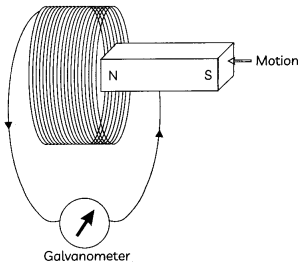
(A) What is the name of the effect being produced by the moving magnet? (1)
(B) State what happens to the needle shown on the galvanometer when the magnet is moving away from the coil. (1)
(C) If the magnet is moved towards the coil at a great speed, state two changes that you would notice in the galvanometer.
OR
List three sources of magnetic fields. Why can not two magnetic field lines intersect? (2)
Answer:
(A) Electromagnetic induction
The process by which a changing mangetic field in a conductor induces a current in another conductor is called electromagnetic induction. In practice, we can induce the current in a coil either by moving it in a magnetic field or by changing the magnetic field arount it.
Experiment:
- Take two differenet coils of copper wire having a large number of turns (say 50 and 100 turns respectively).
- Insert them over a non-conducting cylindrical roll as shown in the figure given below:
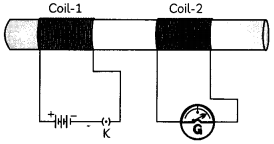
Current is induced in coil-2 when current in coil-1 is changed
(B) When the magnet is moving away from the coil the galvanometer gives a deflection to the left.
There will be induced current in the coil due to relative motion between the magnet and the coil. Changing the magnetic field around the coil generates induced current.
(C) If the magnet is moved towards the coil at a great speed, large deflection occurs to the right and that too more quickly.
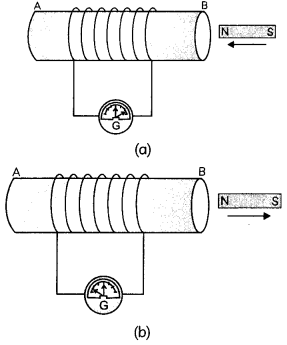
OR
Three sources of magnetic fields are Electromagnet, permanent magnet, wire carrying current.
Two magnetic field lines never intersect because the resultant force on a north pole at any point can only be in one direction. But if two magnetic field lines intersect one another, then the resultant force on a north pole placed at the point of intersection will be along two directions, which is not possible.
Question 15.
Study the given data and answer the questions that follow:
| Parental Plants cross fertilised and seeds collected | F 1 generation (First generation offspring) | F 2 generation (offspring of self pollination of F 1 generation) |
| Male Parents always tall | 88 seeds sown and observed | 88 seeds sown and observed |
| Female parents always dwarf | All 88 plants appeared tall | 66 plants appeared tall and 22 appeared short. |
(A) What is the term used for this type of cross? (1)
(B) What does the data for the column marked F
1
indicate? (1)
(C) Express the genotype of the (i) Parents (ii) F
1
Progeny (iii) F
2
Progeny.
OR
The two versions of a trait (character) are brought in the progeny by the male and female gametes. Explain (2)
Answer:
(A) The term used for this type is Monohybrid cross.
(B) The data for the column marked Fi indicates that tallness is dominant over dwarfness.
(C) The genotypes are:
(i) Parents TT, tt
(ii) F
1
progeny Tt

(iii) F
2
progency
1 : 2: 1
3 tall: 1 dwarf
Here TT are tall plants and tt are dwarf plants.
Explanation: Monohybrid cross
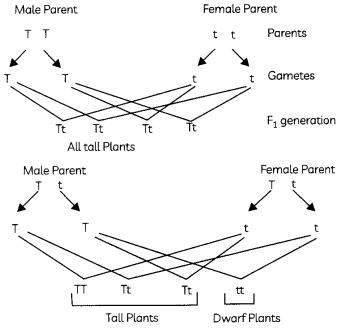
- In a monohybrid cross, only one of the two contrasting traits (characters) appeared in F 1 generation and both the parents traits appeared in certain proportion in F 2 generation.
- There is a pair of unit factors controlling height in a plant.
- In F 1 generation, only one character was expressed. Mendel called it as dominant trait. The trait which was not expressed was termed recessive trait The phenomenon of appearance of one of the contrasting traits in F 1 generation is termed as dominance.
- The traits are not lost when they are not expressed.
- When F 1 offsprings were self pollinated, both the parental traits were expressed in definite proportion in F 2 generation.
OR
The two versions of a trait which are brought in by the male and female gametes are situated on copies of the same chromosome. Each parent contributes one copy of the gene for a particular trait. Thus, there are two copies of each chromosome.
One of the chromosomes (of each pair) comes from the father through male gamete and the other chromosome (of each pair) comes from mother through the female gamete. After the process of fertilization, the zygote is produced having 23 pairs of chromosomes. Sex chromosomes carry genes for sexual characters.